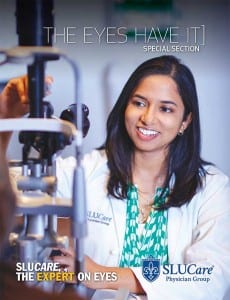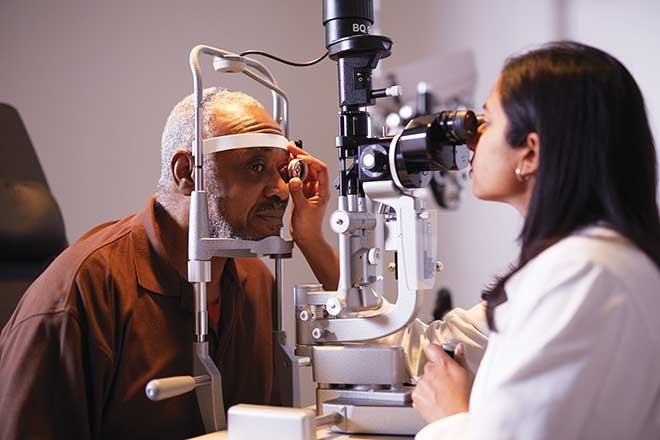Were it not for hair-trigger reflexes and “the will of God,” Ernest McClain says he likely would have met a sticky end. It was dark on South Broadway that night three years ago, and his eyes were failing; he didn’t see the 2-foot-deep hole in the road until it was almost too late. “I could have had my grandchildren with me,” McClain, 57, says. “That’s what made me seek help.” The lifelong St. Louisan always has had trouble with his eyes. He was nearsighted as a little boy and heavily dependent on eyeglasses. In later life, poor sight became poorer. McClain developed glaucoma—an eye disease that results in damage to the optic nerve—and cataracts (a gradual clouding of the lens, usually later in life), which are not necessarily related to glaucoma, but can contribute to its effects. With both problems impeding his vision, night driving was perilous, daytime was cloudy.
 “We call it ‘the silent thief,’” says Dr. Anitra Turner, SLUCare ophthalmologist and McClain’s physician. “There aren’t many symptoms until it’s in advanced stages.” This is particularly true of open-angle glaucoma, the most common form, which is caused by the gradual clogging of drainage canals, and results in pressure. The other common type of glaucoma, angle-closure glaucoma, is due to more sudden blockage and can come on quickly. This kind of eye pressure, Turner says, is believed to cause damage to the nerve by mechanically pressing on it. But some with normal eye pressure also experience glaucoma. Another theory cites poor blood flow to the nerve as a possible cause. Although Turner says it isn’t known for sure why glaucoma occurs, diabetes, smoking and a family history of the disease increase risk.
“We call it ‘the silent thief,’” says Dr. Anitra Turner, SLUCare ophthalmologist and McClain’s physician. “There aren’t many symptoms until it’s in advanced stages.” This is particularly true of open-angle glaucoma, the most common form, which is caused by the gradual clogging of drainage canals, and results in pressure. The other common type of glaucoma, angle-closure glaucoma, is due to more sudden blockage and can come on quickly. This kind of eye pressure, Turner says, is believed to cause damage to the nerve by mechanically pressing on it. But some with normal eye pressure also experience glaucoma. Another theory cites poor blood flow to the nerve as a possible cause. Although Turner says it isn’t known for sure why glaucoma occurs, diabetes, smoking and a family history of the disease increase risk.
While the condition, usually affecting both eyes, is irreversible, its progression can be slowed by pressure-reducing treatments. “Minimally invasive procedures do exist, but they are not as effective as more invasive surgeries,” Turner explains. The operations involve eye drainage in the hope that the eyes will take over the job themselves afterward. The surgery usually is done with local anesthesia and involves making a tiny drainage hole in the white of the eye. “The benefits of glaucoma surgery can last a year, five years or 30. It really depends.”
Drops also help to reduce pressure, and Turner says she doesn’t recommend surgery until all four classes of drops have been tried. “Our goal is twofold: to slow the disease to the point where you don’t notice it, and to make the eyes outlast the body.” Most of the patients Turner sees are age 60 and above, but she cautions that people in their 20s and 30s also can be afflicted.
It can be preferable, she says, to receive care in a larger facility like SLU where there is a range of doctors. “As an academic center, SLUCare has many ophthalmology subspecialists, including experts in low vision, which can be crucial for glaucoma patients to maintain their ability to function,” Turner says. “I refer my advanced glaucoma patients to our low vision specialist, and they like the convenience that comes with being in the same building as I am.”
Turner’s patient Ernest McClain says the doctor prescribed drops and very recently, he had cataract surgery on a second eye. He says now he’s a new man. “When they took those bandages off after the operation, the tears just rolled down; I knew a miracle had taken place,” he says. “Those SLU doctors … I call them my angels.”
Pictured: Ernest McClain and Dr. Anitra Turner
Photo courtesy of SLUCare Physician Group
For more information on SLUCare ophthalmology, call 314.256.3200 or visit slucare.edu/eyes. Pictured on the cover: SLUCare ophthalmologist Dr. Anitra Turner.
Cover design by ALLIE BRONSKY | Cover photo courtesy of SLUCare physician group








